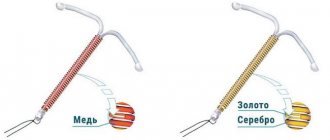Pros and cons of barrier types of contraception
There are a number of undoubted advantages in using barrier methods of contraception:
- Availability – the required type of protection can be purchased at almost any pharmacy.
- Relatively low cost - barrier contraceptives are much cheaper than hormonal contraception.
- Safety - there is a slight risk of hypersensitivity to latex or other components of contraceptives.
- Additional protection against sexually transmitted diseases, which is not provided by the intrauterine device and hormones.
- They are available without a prescription, so there is no need to stand in long lines to see a doctor.
Despite the large number of advantages, barrier contraceptives have a number of disadvantages:
- Reduce the intensity of sensations during sexual intercourse.
- There remains a possibility of developing an allergy.
- The need to pause every time before sexual intercourse to put on a condom, insert a diaphragm, etc.
- Not as effective as the intrauterine device or oral contraceptives.
A little more needs to be said about the effectiveness of barrier contraceptives. It is measured by the Pearl index, which shows how many women out of 100 will have an egg fertilized when using a particular contraceptive.
Important! The lower the index, the safer the method.
| Method of contraception | Perl index value |
| Male sterilization | 0,15 |
| Sterilization of a woman | 0,4 |
| Hormonal contraceptives | 0,5 |
| Intrauterine device | 1 |
| Male condom | 12 |
| Female condom | 5 – 25 |
| Coitus interruptus | 19 |
| Spermicides | 21 |
| Having sex only on “safe” days | 24 |
| No contraceptives | 85 |
Female condoms
This barrier method of contraception appeared much later than the male method. Female condoms are also called femidomi. They are made of latex and polyurethane, so if you are allergic to the first material, they are not suitable for a woman. In other cases, the product is quite convenient and makes the woman independent of the man in terms of contraception. A condom is the same latex tube, but with a much larger diameter - 50-105 mm. The length also depends on the chosen size and can be 8-18 cm. There are special rings at both ends of the product.
The external one does not allow the contraceptive to enter the vagina and covers all the labia, and the internal one is inserted inside, representing a diaphragm. Its diameter is much smaller.
Varieties
There are two main classifications of barrier contraceptives. According to the first, there are two types of contraceptives: female and male.
With men, everything is clear - they use condoms. But there are many more methods of contraception for women and some of them have not yet been fully researched. More details about birth control methods for women can be found in the corresponding section.
There is another classification, which is based on the mechanism of action of the contraceptive:
- mechanical;
- chemical;
- combined - combines everything, mechanical and physical, types.
Mechanical contraceptive
This type of protection includes products that prevent sperm from entering the uterus:
- condoms;
- diaphragms;
- caps.
The principle of action of condoms for men and women is the same. Only their appearance and method of application differ.
Advice! Condoms provide the best protection against the transmission of sexually transmitted diseases.
Chemical
Chemical contraceptives are also called spermicides. These are substances that can destroy the cell wall of male reproductive cells. And this, in turn, disrupts their movement and ultimately leads to the death of sperm. There are many forms of spermicide release:
- gels;
- cream;
- foam;
- aerosols;
- vaginal tablets;
- vaginal suppositories.
Combined
A combined method of contraception involves a combination of mechanical and chemical contraception. Vaginal sponges have this property.
Separately, there is a double barrier method of contraception. It involves the simultaneous use of mechanical protection (condom) and chemical (spermicide). This method is considered more effective.
Men's protection
The only protection option used by men is condoms. They are made from sheep caecum, collagen, polyurethane and latex. The principle of operation is to prevent sperm from entering the vagina. In this case, only latex contraceptives can delay the penetration of pathogens of sexually transmitted diseases into the body. Barrier products made from biological materials have a porous structure through which microorganisms can easily pass. Latex does not have any pores at all, even at the highest magnification, so it is believed that the material is capable of retaining absolutely any germs of the genital organs.
At the same time, the products do not protect against infections transmitted through skin contact, since they do not cover the entire contact surface of the body.
To facilitate use, all latex contraceptive products must be treated with a special lubricant, which can be made from silicone or water. If you want to add lubricants, you should not use petroleum jelly, creams or any vegetable or animal oils or fats, as this significantly reduces the effectiveness of the condoms. In such cases, it is better to use special gels or glycerin.
The quality of any product depends on the characteristics of its production, the timing and conditions of its storage. The longer the condom is stored, the less elastic and durable its surface will become.
Barrier methods of contraception for women
There is a wide variety of barrier contraceptives for women on the modern market. This is due to the fact that this type of protection is gaining increasing popularity. Especially among young people who are sexually active. And for good reason. After all, female barrier contraceptives have many advantages compared to taking hormonal pills and placing an intrauterine device.
Female condoms
The female condom is also called a femid. It got its name from a combination of two English words: female - woman, condom - condom.
The product is a tube up to 18 cm long and up to 8 cm in diameter. It has two rings: inner and outer. The internal one is necessary to fix the condom in the vagina in front of the cervix, and the external one covers the labia majora.
For the use of femidom to be effective, you need to follow the instructions and put on and remove the condom correctly. And this is done as follows:
- The woman takes a position that is comfortable for her.
- Takes the product with one hand by the inner ring and squeezes it so that it can be inserted into the vagina.
- Inserts the condom like a tampon as deeply as possible.
- Then he inserts his finger there to straighten the condom and push it deeper.
- During sex, it is better to insert the penis of your sexual partner yourself so that it fits into the hole of the condom, and not between it and the vaginal wall.
- You need to pull out the product immediately after sex, after twisting it to prevent sperm from getting inside.
The use of a vaginal condom has a number of undoubted advantages over other barrier contraceptives for women:
- there is no dependence on the erection of the penis of the sexual partner;
- the integrity of the vaginal mucosa is preserved;
- can be inserted inside 10 hours before sex;
- made of polyurethane, so can be used by those who are allergic to latex;
- more reliably prevents infection with sexually transmitted diseases.
Diaphragms
The diaphragm is a latex cap coated with spermicide. Depending on the structure of the rim, there are several varieties:
- flat;
- ring;
- curved.
There are also several sizes: from 55 to 95 mm. The required size and shape is selected individually by the doctor.
If the diaphragm is chosen correctly, it fits tightly during sexual intercourse and does not cause discomfort. The girl inserts it inside just before sexual intercourse. She remains there for another eight hours. After this, you need to remove the diaphragm, wash it with soap and disinfect it for 20 minutes in a solution of ethyl alcohol.
Important! The undoubted advantage of the diaphragm over many other barrier contraceptives for women is the possibility of repeated use.
But this method of protection also has a number of disadvantages:
- cannot be used for infections of the genital organs, any pathological conditions of the cervix, congenital defects of the vaginal structure;
- may cause an allergic reaction;
- less effective than condoms;
- the need to carry out some manipulations with the vagina immediately before sexual intercourse, which can “discourage desire.”
Caps
This contraceptive is shaped like a cup that is inserted into the cervix. There are several types of caps.
Some are administered only by a doctor for the entire period between menstruation, while some can be administered by a woman independently before sexual intercourse. In the latter case, the cap remains inside for up to two days. Caring for the cap, the pros and cons of its use are similar to those of the diaphragm.
Spermicides
Chemical contraceptives are inserted into the vagina before sexual intercourse. Their action begins almost immediately after ingestion. Spermicides destroy sperm within a few seconds. Such a high speed is very important, since male reproductive cells enter the cervix within a couple of seconds after ejaculation, and after a minute and a half they are already in the fallopian tubes.
Chemical contraceptives also reduce the risk of transmitting sexually transmitted infections, but less so than mechanical methods. They are also not very effective in preventing pregnancy, so they are most often used as part of a double barrier method of contraception.
Spermicides come in many different forms. The desired shape is selected depending on the girl’s preferences and the abundance of lubricant.
Aerosols and foams
Spermicides in the form of aerosols and gels are the most universal remedy. Suitable for almost everyone. They are drawn into a special applicator and, with its help, inserted into the vagina. The applicator can be used repeatedly. But after each use you need to disinfect it.
Creams and gels
The use of creams and gels is best for girls who lack lubrication. They are also administered using an applicator. These release forms have proven themselves better than suppositories and tablets. They do not cause a burning sensation, unlike the latter.
Tablets and suppositories
Tablets and suppositories are best used when there is excess lubricant. In this case, the effect of spermicides does not occur immediately. You need to wait 15 - 20 minutes until they dissolve. They are recommended to be administered orally a little in advance.
Their advantage over other types of spermicides is their low cost, which is why they are in great demand.
Vaginal sponges
The sponge combines mechanical and chemical protection. This is exactly what is called a combined contraceptive. The fibers of the sponge create a mechanical obstacle to male reproductive cells, and the substance contained in the sponge leads to the death of sperm.
It can be natural or synthetic, made from polyurethane. They look like little round pads with an indentation in the middle and a pull out loop on the other side. They are inserted in such a way that the recess is adjacent to the cervix, and the loop is on the side of the vaginal outlet.
The sponge is put on before sex and can be left in for up to 6 hours.
Warning! This contraceptive cannot be reused.
Cervical cap
This is a small diaphragm that covers only the cervix. The caps have different sizes, so they are selected only by a gynecologist. Made from rubber.
In general, all the pros and cons are the same as those of the diaphragm.
Mechanical devices also include non-hormonal intrauterine devices (IUDs).
ATTENTION! It is strictly forbidden to use petroleum jelly or oil-based lubricants with the contraceptives described above. This may result in loss of product integrity.
When and why you should not take birth control pills
There can be many reasons for a ban; let’s look at the most common cases:
- Breastfeeding a baby
. Many people think that it is impossible to get pregnant during lactation, but a good gynecologist will definitely tell you that this is not so. Indeed, milk production is associated with increased levels of the hormone prolactin, which affects ovulation and pregnancy, but each person’s body is individual. Therefore, cases of pregnancy during breastfeeding are not uncommon. - Hormonal imbalances
. There are dozens of diseases associated with hormonal problems. Moreover, this is not only gynecology - it also includes endocrine disorders in the thyroid gland, diseases of the pituitary gland, and problems with the pancreas. Hormone therapy is used for kidney diseases, treatment of tumors, etc. In all these cases, you need to take strictly specific medications. Doses of hormones are calculated, and no other hormonal drugs can be taken. Otherwise, you can disrupt the necessary processes, because the entire hormonal system is interconnected. - Allergies to hormones and side effects
. This condition is rare, but it is impossible not to talk about it. Some women, taking hormones, gain weight, some begin to have liver pain, and some constantly feel sick. In this case, you need to contact a gynecologist and choose a suitable method of long-term protection, for example, installing a spiral. - Menstrual irregularities
. In this case, taking birth control pills is simply pointless, because you need to start taking them on the first day of your period without skipping. Until the gynecologist identifies the cause and prescribes treatment, you will have to protect yourself using your grandmother’s old method - barrier methods.









